Various Works Read online
Page 16
and 'after' what is nearer, but in the future we call the nearer
'before' and the farther 'after'. So that since the 'before' is in
time, and every movement involves a 'before', evidently every change
and every movement is in time.
It is also worth considering how time can be related to the soul;
and why time is thought to be in everything, both in earth and in
sea and in heaven. Is because it is an attribute, or state, or
movement (since it is the number of movement) and all these things are
movable (for they are all in place), and time and movement are
together, both in respect of potentiality and in respect of actuality?
Whether if soul did not exist time would exist or not, is a question
that may fairly be asked; for if there cannot be some one to count
there cannot be anything that can be counted, so that evidently
there cannot be number; for number is either what has been, or what
can be, counted. But if nothing but soul, or in soul reason, is
qualified to count, there would not be time unless there were soul,
but only that of which time is an attribute, i.e. if movement can
exist without soul, and the before and after are attributes of
movement, and time is these qua numerable.
One might also raise the question what sort of movement time is
the number of. Must we not say 'of any kind'? For things both come
into being in time and pass away, and grow, and are altered in time,
and are moved locally; thus it is of each movement qua movement that
time is the number. And so it is simply the number of continuous
movement, not of any particular kind of it.
But other things as well may have been moved now, and there would be
a number of each of the two movements. Is there another time, then,
and will there be two equal times at once? Surely not. For a time that
is both equal and simultaneous is one and the same time, and even
those that are not simultaneous are one in kind; for if there were
dogs, and horses, and seven of each, it would be the same number.
So, too, movements that have simultaneous limits have the same time,
yet the one may in fact be fast and the other not, and one may be
locomotion and the other alteration; still the time of the two changes
is the same if their number also is equal and simultaneous; and for
this reason, while the movements are different and separate, the
time is everywhere the same, because the number of equal and
simultaneous movements is everywhere one and the same.
Now there is such a thing as locomotion, and in locomotion there
is included circular movement, and everything is measured by some
one thing homogeneous with it, units by a unit, horses by a horse, and
similarly times by some definite time, and, as we said, time is
measured by motion as well as motion by time (this being so because by
a motion definite in time the quantity both of the motion and of the
time is measured): if, then, what is first is the measure of
everything homogeneous with it, regular circular motion is above all
else the measure, because the number of this is the best known. Now
neither alteration nor increase nor coming into being can be
regular, but locomotion can be. This also is why time is thought to be
the movement of the sphere, viz. because the other movements are
measured by this, and time by this movement.
This also explains the common saying that human affairs form a
circle, and that there is a circle in all other things that have a
natural movement and coming into being and passing away. This is
because all other things are discriminated by time, and end and
begin as though conforming to a cycle; for even time itself is thought
to be a circle. And this opinion again is held because time is the
measure of this kind of locomotion and is itself measured by such.
So that to say that the things that come into being form a circle is
to say that there is a circle of time; and this is to say that it is
measured by the circular movement; for apart from the measure
nothing else to be measured is observed; the whole is just a plurality
of measures.
It is said rightly, too, that the number of the sheep and of the
dogs is the same number if the two numbers are equal, but not the same
decad or the same ten; just as the equilateral and the scalene are not
the same triangle, yet they are the same figure, because they are both
triangles. For things are called the same so-and-so if they do not
differ by a differentia of that thing, but not if they do; e.g.
triangle differs from triangle by a differentia of triangle, therefore
they are different triangles; but they do not differ by a
differentia of figure, but are in one and the same division of it. For
a figure of the one kind is a circle and a figure of another kind of
triangle, and a triangle of one kind is equilateral and a triangle
of another kind scalene. They are the same figure, then, that,
triangle, but not the same triangle. Therefore the number of two
groups also-is the same number (for their number does not differ by
a differentia of number), but it is not the same decad; for the things
of which it is asserted differ; one group are dogs, and the other
horses.
We have now discussed time-both time itself and the matters
appropriate to the consideration of it.
Book V
1
EVERYTHING which changes does so in one of three senses. It may
change (1) accidentally, as for instance when we say that something
musical walks, that which walks being something in which aptitude
for music is an accident. Again (2) a thing is said without
qualification to change because something belonging to it changes,
i.e. in statements which refer to part of the thing in question:
thus the body is restored to health because the eye or the chest, that
is to say a part of the whole body, is restored to health. And above
all there is (3) the case of a thing which is in motion neither
accidentally nor in respect of something else belonging to it, but
in virtue of being itself directly in motion. Here we have a thing
which is essentially movable: and that which is so is a different
thing according to the particular variety of motion: for instance it
may be a thing capable of alteration: and within the sphere of
alteration it is again a different thing according as it is capable of
being restored to health or capable of being heated. And there are the
same distinctions in the case of the mover: (1) one thing causes
motion accidentally, (2) another partially (because something
belonging to it causes motion), (3) another of itself directly, as,
for instance, the physician heals, the hand strikes. We have, then,
the following factors: (a) on the one hand that which directly
causes motion, and (b) on the other hand that which is in motion:
further, we have (c) that in which motion takes place, namely time,
and (distinct from these three) (d) that from which and (e) that to
which it proceeds: for every motion proceeds from something and to
something, th
at which is directly in motion being distinct from that
to which it is in motion and that from which it is in motion: for
instance, we may take the three things 'wood', 'hot', and 'cold', of
which the first is that which is in motion, the second is that to
which the motion proceeds, and the third is that from which it
proceeds. This being so, it is clear that the motion is in the wood,
not in its form: for the motion is neither caused nor experienced by
the form or the place or the quantity. So we are left with a mover,
a moved, and a goal of motion. I do not include the starting-point
of motion: for it is the goal rather than the starting-point of motion
that gives its name to a particular process of change. Thus
'perishing' is change to not-being, though it is also true that that
that which perishes changes from being: and 'becoming' is change to
being, though it is also change from not-being.
Now a definition of motion has been given above, from which it
will be seen that every goal of motion, whether it be a form, an
affection, or a place, is immovable, as, for instance, knowledge and
heat. Here, however, a difficulty may be raised. Affections, it may be
said, are motions, and whiteness is an affection: thus there may be
change to a motion. To this we may reply that it is not whiteness
but whitening that is a motion. Here also the same distinctions are to
be observed: a goal of motion may be so accidentally, or partially and
with reference to something other than itself, or directly and with no
reference to anything else: for instance, a thing which is becoming
white changes accidentally to an object of thought, the colour being
only accidentally the object of thought; it changes to colour, because
white is a part of colour, or to Europe, because Athens is a part of
Europe; but it changes essentially to white colour. It is now clear in
what sense a thing is in motion essentially, accidentally, or in
respect of something other than itself, and in what sense the phrase
'itself directly' is used in the case both of the mover and of the
moved: and it is also clear that the motion is not in the form but
in that which is in motion, that is to say 'the movable in
activity'. Now accidental change we may leave out of account: for it
is to be found in everything, at any time, and in any respect.
Change which is not accidental on the other hand is not to be found in
everything, but only in contraries, in things intermediate contraries,
and in contradictories, as may be proved by induction. An intermediate
may be a starting-point of change, since for the purposes of the
change it serves as contrary to either of two contraries: for the
intermediate is in a sense the extremes. Hence we speak of the
intermediate as in a sense a contrary relatively to the extremes and
of either extreme as a contrary relatively to the intermediate: for
instance, the central note is low relatively-to the highest and high
relatively to the lowest, and grey is light relatively to black and
dark relatively to white.
And since every change is from something to something-as the word
itself (metabole) indicates, implying something 'after' (meta)
something else, that is to say something earlier and something
later-that which changes must change in one of four ways: from subject
to subject, from subject to nonsubject, from non-subject to subject,
or from non-subject to non-subject, where by 'subject' I mean what
is affirmatively expressed. So it follows necessarily from what has
been said above that there are only three kinds of change, that from
subject to subject, that from subject to non-subject, and that from
non-subject to subject: for the fourth conceivable kind, that from
non-subject to nonsubject, is not change, as in that case there is
no opposition either of contraries or of contradictories.
Now change from non-subject to subject, the relation being that of
contradiction, is 'coming to be'-'unqualified coming to be' when the
change takes place in an unqualified way, 'particular coming to be'
when the change is change in a particular character: for instance, a
change from not-white to white is a coming to be of the particular
thing, white, while change from unqualified not-being to being is
coming to be in an unqualified way, in respect of which we say that
a thing 'comes to be' without qualification, not that it 'comes to be'
some particular thing. Change from subject to non-subject is
'perishing'-'unqualified perishing' when the change is from being to
not-being, 'particular perishing' when the change is to the opposite
negation, the distinction being the same as that made in the case of
coming to be.
Now the expression 'not-being' is used in several senses: and
there can be motion neither of that which 'is not' in respect of the
affirmation or negation of a predicate, nor of that which 'is not'
in the sense that it only potentially 'is', that is to say the
opposite of that which actually 'is' in an unqualified sense: for
although that which is 'not-white' or 'not-good' may nevertheless he
in motion accidentally (for example that which is 'not-white' might be
a man), yet that which is without qualification 'not-so-and-so' cannot
in any sense be in motion: therefore it is impossible for that which
is not to be in motion. This being so, it follows that 'becoming'
cannot be a motion: for it is that which 'is not' that 'becomes'.
For however true it may be that it accidentally 'becomes', it is
nevertheless correct to say that it is that which 'is not' that in
an unqualified sense 'becomes'. And similarly it is impossible for
that which 'is not' to be at rest.
There are these difficulties, then, in the way of the assumption
that that which 'is not' can be in motion: and it may be further
objected that, whereas everything which is in motion is in space, that
which 'is not' is not in space: for then it would be somewhere.
So, too, 'perishing' is not a motion: for a motion has for its
contrary either another motion or rest, whereas 'perishing' is the
contrary of 'becoming'.
Since, then, every motion is a kind of change, and there are only
the three kinds of change mentioned above, and since of these three
those which take the form of 'becoming' and 'perishing', that is to
say those which imply a relation of contradiction, are not motions: it
necessarily follows that only change from subject to subject is
motion. And every such subject is either a contrary or an intermediate
(for a privation may be allowed to rank as a contrary) and can be
affirmatively expressed, as naked, toothless, or black. If, then,
the categories are severally distinguished as Being, Quality, Place,
Time, Relation, Quantity, and Activity or Passivity, it necessarily
follows that there are three kinds of motion-qualitative,
quantitative, and local.
2
In respect of Substance there is no motion, because Substance has no
contrary among things that are. Nor is there motion in respect of
; Relation: for it may happen that when one correlative changes, the
other, although this does not itself change, is no longer
applicable, so that in these cases the motion is accidental. Nor is
there motion in respect of Agent and Patient-in fact there can never
be motion of mover and moved, because there cannot be motion of motion
or becoming of becoming or in general change of change.
For in the first place there are two senses in which motion of
motion is conceivable. (1) The motion of which there is motion might
be conceived as subject; e.g. a man is in motion because he changes
from fair to dark. Can it be that in this sense motion grows hot or
cold, or changes place, or increases or decreases? Impossible: for
change is not a subject. Or (2) can there be motion of motion in the
sense that some other subject changes from a change to another mode of
being, as e.g. a man changes from falling ill to getting well? Even
this is possible only in an accidental sense. For, whatever the
subject may be, movement is change from one form to another. (And
the same holds good of becoming and perishing, except that in these
processes we have a change to a particular kind of opposite, while the
other, motion, is a change to a different kind.) So, if there is to be
motion of motion, that which is changing from health to sickness
must simultaneously be changing from this very change to another. It
is clear, then, that by the time that it has become sick, it must also
have changed to whatever may be the other change concerned (for that
it should be at rest, though logically possible, is excluded by the
theory). Moreover this other can never be any casual change, but
must be a change from something definite to some other definite thing.
So in this case it must be the opposite change, viz. convalescence. It
is only accidentally that there can be change of change, e.g. there is
a change from remembering to forgetting only because the subject of
this change changes at one time to knowledge, at another to ignorance.
In the second place, if there is to be change of change and becoming

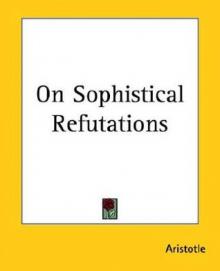 On Sophistical Refutations
On Sophistical Refutations The Categories
The Categories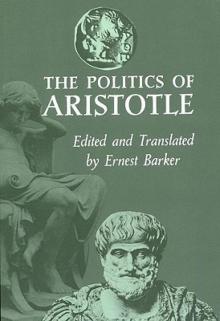 The Politics of Aristotle
The Politics of Aristotle Nicomachean Ethics
Nicomachean Ethics The Rhetoric & the Poetics of Aristotle
The Rhetoric & the Poetics of Aristotle POSTERIOR ANALYTICS
POSTERIOR ANALYTICS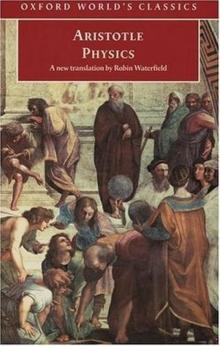 Physics
Physics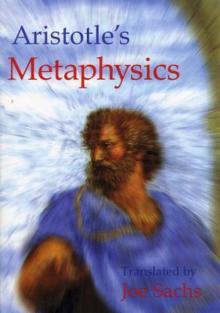 Metaphysics
Metaphysics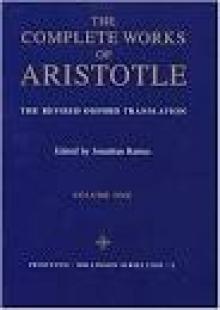 Various Works
Various Works